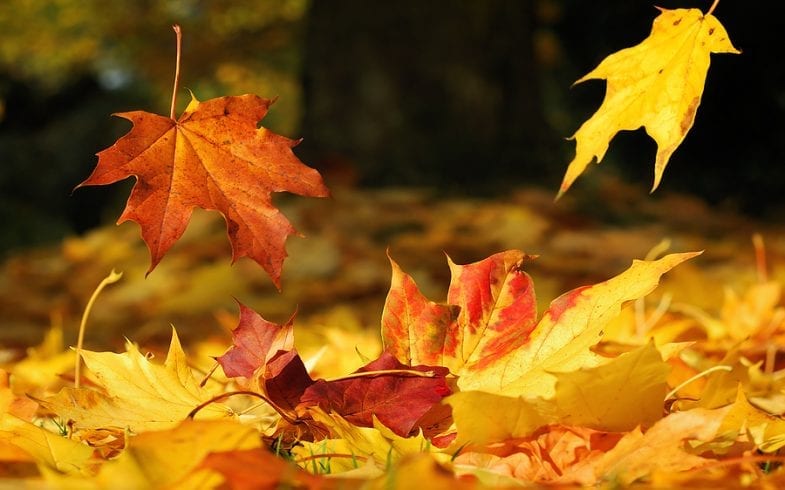FALLING LEAVES ARE A GIFT FROM NATURE

The leaves are turning beautiful colors, one of the great wonders of nature. Different species and varieties of trees provide us with fiery displays of foliage and when put together in a forest they create a spectacle of color that attracts thousands of people to travel long distances to view it.
Steinbeck said fall color is the most intense in the Northeast of America. My son lives in upper New York and works in the Berkshires where the roads are becoming crowded with what the locals call “leaf peepers”. Leaf color triggers in our minds that the leaves will soon be falling and leaf clean up will be taking place. I remember becoming part of the recycling committee in its infancy.
At the time, leaves where being collected by municipalities and sent to upstate New York to be burned. As an environmentalist and an organic gardener believing that everything that comes from the earth should go back into the earth this was horrifying. Nature has given us not only a display of unparallel beauty, but also a miracle of creative change and a renewable source of energy.
It has provided us a clear path to follow and when we deviate from her plan it is disastrous. When we burned leaves, we polluted our air and contributed to global warming. When we do not allow our leaves to compost, we rob our soil of important nutrients. When we do not take time to marvel at its beauty, we rob our soul of one of nature’s great gifts.
Leaf mold is one of the best things we can do for our soils. Good soils are the strength of any nation. Leaf mold is very rich in carbon and should be added to all soil beds and is of particular importance to acid loving plants. This includes foundation beds, rows of border plants used to provide you with screening, perennial beds, tree beds and shrub beds.
Adding 2 inches of leaf mold will make a big difference to your soil for years. Carbon is what feeds the microbial life in your soil and the microbes are the key to healthy soil and developing a sustainable garden. Screening your yard for privacy has
become very important for most home owners. Many hedges or border plantings have lost their bottom branches due to lack of vigor and lack of proper pruning. You will find that your plants will do better with just one application of leaf mold and the results will last for years as you build up your food web within the rhizosphere of your plants. This is what creates a sustainable garden.
LET THE MICROBES IN YOUR SOIL WORK FOR YOU DAY AND NIGHT.
Leaf mold is produced by fungal decomposition. Leaf mold serves as a soil conditioner rather than a natural fertilizer.
Its main advantages are the minerals it releases and its ability to retain 4 1/2 times its weight in water. The high quantity of minerals in leaf mold comes from the roots of trees that permeate deep into the soil and bring rich minerals up into the leaves. Many people consider this to be better than mineral rock dust in supplying minerals to your soil.
Leaf mold changes the structure of the soil. Fungus development is the key benefit to the soil. The little root hairs of the fungus grab onto the soil particles which help bind loose soil and at the same time help to break up compact soil. The fungus will move into the surrounding soil in all directions which improve the surrounding soil.
Of particular interest to gardeners is a fungus called Mycorrhizae. Mycorrhizal fungi extend the reach of some 95 % of all plants. The fungus forms a symbiotic relationship with the roots of plants and the carbon available in the soil. In return for carbon in root exudates, fungi break down organic matter and absorb needed nutrients from the soil and then transport and deliver these product to exchange sites inside the roots.
With this fungus the root systems of plants become stronger and develop deeper into the soil. This is what makes plants healthy and self sustaining. Leaf mold will continue to break down into the soil and will last a lifetime. As it breaks down, it will release humic acids, carbohydrates, lipids and stuff I have never heard of. It is complex and impossible to manufacture. My
M father considered leaf mold to be black gold and as kids he had us collect leaf mold from the woods. It was one of his secret ingredients in our organic soil mix.
Leaves are high in carbon, an essential ingredient in any compost pile. Composting should become a part of any organic gardening program. It is a process that we can build up our soils by adding both structure and microbes to feed the soil food web. Leaf mold can be brewed into compost tea. Compost and compost tea are the secretes to beautiful gardens.
Everyone who owns an organic garden needs to compost. In my book ’12 Steps to Natural Gardening’ on page 79 you can learn how to compost and build compost bins. Hopefully you all have my book for it was written as a learning tool helping you with successful organic gardening. It is a quick reference aid as you follow the sequence of events that takes place in nature.
A quick review giving you the knowledge to make the right decisions. Timing is important and we need to react to nature’s calendar. We need to work with nature and enhance her efforts and not work against her. We need to learn to take advantage of the many gifts she provides.



